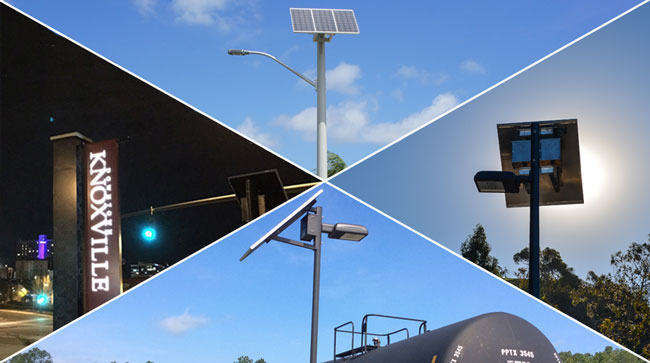


There are many variations when it comes to solar-powered lighting systems, and it is difficult to compare them to one another. Each manufacturer has its design parameters, and understanding these differences will allow you to make an educated determination if the system will meet your design needs. Here are some examples and the differences between various companies.
Every solar power assembly is sized specifically to the light fixture or load parameter that it is powering. The size of the solar power assembly is either determined by design requirements by the end-user or by a technician that uses a basic formula for all systems. This sets apart one manufacturer from the next.
Systems that provide integrated solar power assemblies into an “all in one” solution have set the solar to provide x amount of charge no matter where the solar-powered light is located geographically. This means that the same panel they sell someone in Texas, they will sell in Michigan, and the two systems will work completely differently from one another, even though they are designed the same. This is due to the lack of sunlight in the winter months in northern locations. These types of systems do not work well in commercial applications and are not considered reliable systems.
Many manufacturers take into consideration the local conditions of the project and use those figures to determine how much solar is required to adequately power the light fixture or load. This provides a custom solution and ensures that the system is designed more reliably than its "all-in-one" counterparts. This does not mean that all separated systems are sized correctly and a more in-depth analysis of the system that is being quoted will show this.
Solar panels charge the batteries during the day, and the batteries power the light fixture or load at night. Pretty simple, but if the batteries are sized for only the amount of storage to operate the fixture for one night, the maintenance schedule will be much different from systems that provide minimum autonomy. This also varies greatly between manufacturers. Depending on what the end-user is expecting for the maintenance and longevity of a system will help determine what suits the end-user best.
There are two main battery technologies used in these systems; Lithium and AGM or Gel. Lithium is meant to be taken down to its max depth of discharge on a regular basis and can last in the field under optimum conditions for quite some time. However, one day of not optimum sunshine, and the system will not operate properly that night or until full sun is available during the day. These batteries are also still very expensive and only add a year or two to the maintenance schedule of the system
Gel or AGM technology is much larger and heavier and is typically sized to only use about 20% of the depth of discharge per night. This provides plenty of back-ups to ensure that on days when the sun isn't shining to its fullest potential, the system will still operate as designed at night. This is crucial, especially in systems where safety and security are key. These batteries tend to need replacing every five years or so but have a much lower cost than their Lithium counterparts.
Different control options are always available. There are a lot of adaptive lighting controls on the market today being used by all different manufacturers. Some allow the system to do as it will when it comes to lighting as the controller, being the brains of the system, dims and turns off the lights as it sees it should due to battery discharge rates. There is no set schedule, and the lights are advertised as operating from dusk to dawn, though the light may only operate at 10% during the night and only operate at full intensity during times when the battery is full or there is motion.
There are manufacturers that can provide strict dusk-to-dawn lighting with no dimming or adaptive controls that take over without the owner knowing about it. This is always completed by the system design engineers and should always be visible in the system specifications. You definitely don’t want to be left out in the dark when you least expect it. Going over system specifications and requirements with the designing company, along with reading all the fine print, will make sure your system is going to be operating as you expect it to.
Solar light fixtures have come a long way in the past 10 years with the integration of LED fixtures. LEDs have even advanced drastically over the last few years with many changes in lumen output and longevity. Looking at the lumen output, wattage, and longevity of the fixture will allow for the best determination of the amount of light output the fixture has, as well as how long the light fixture will last. 100k hours is about standard today, but that is also increasing steadily, as well as a higher lumen output per LED, allowing for the same amount of light out of a much lower wattage fixture than ever before.
Looking over the specifications of different systems will show the differences and similarities, allowing you to compare apples to apples. There are many variances in systems on the market today. Purchasing a system from a reliable manufacturer will make sure your system is there for the long run, and the company will stand behind the system for years to come.
